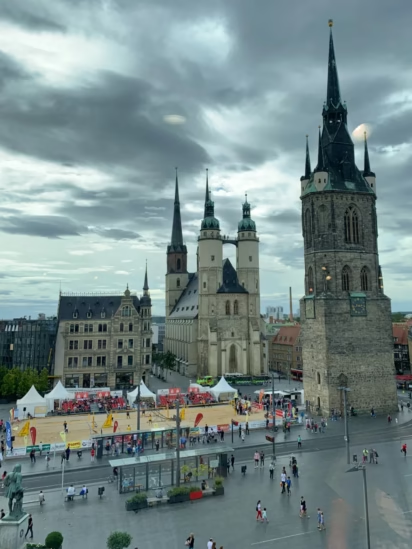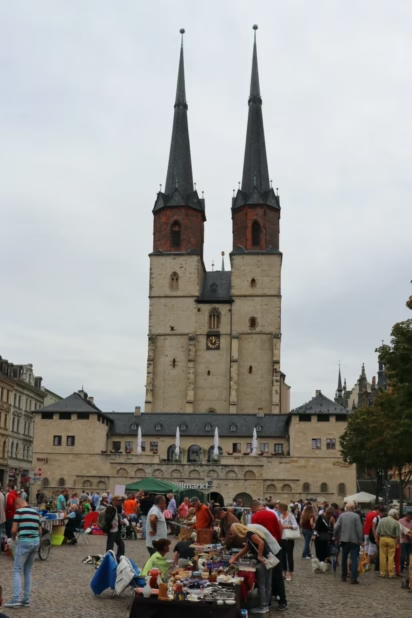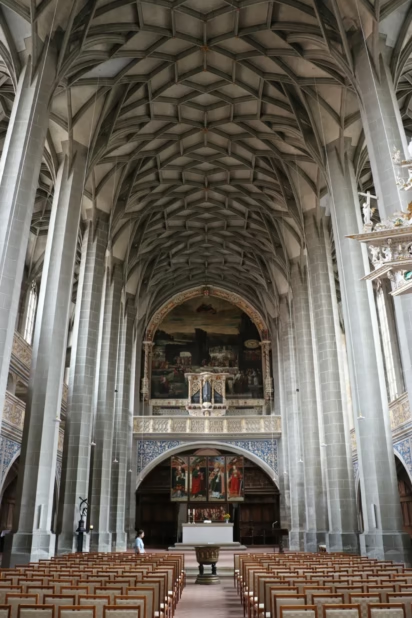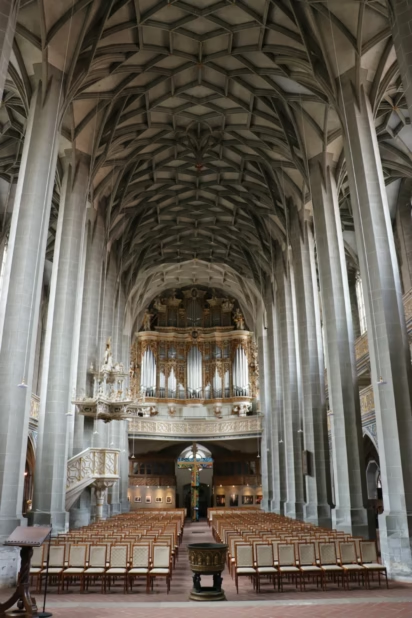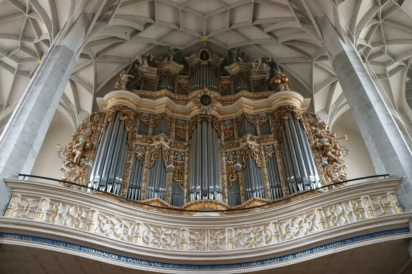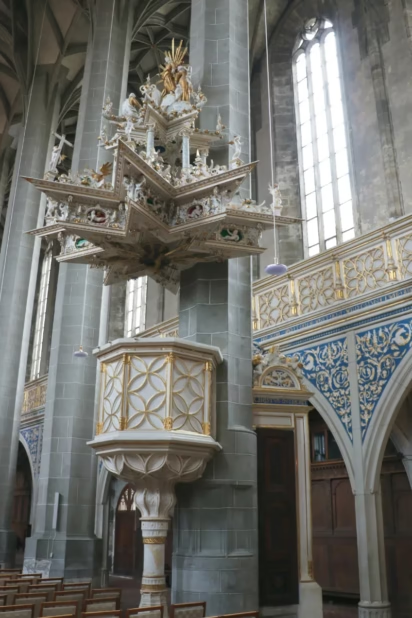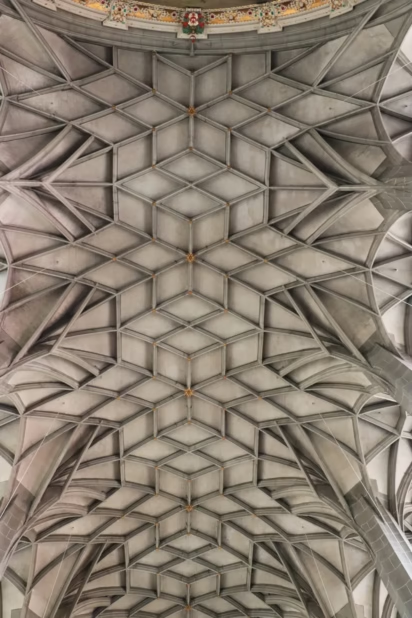The late Gothic Marktkirche Unser Lieben Frauen in Halle has organs familiar to Handel and Bach, art by Cranach, and four towers from two previous churches.

The Marktkirche Unser Lieben Frauen (Market Church of Our Dear Lady), or the Marienkirche (St Mary’s), in Halle an der Saale is a late Gothic hall church built mostly between 1529 and 1554. The original idea was to impress the locals with its Roman Catholic magnificence but the city turned Lutheran before its completion and the powerful archbishop had to leave town. Today it is known for its four towers — all from previous churches — and its sober late Gothic interior. Bach would recognize the organ case while the organ on which Handel took his first lessons is still played.
Marktkirche Unser Lieben Frauen in Halle
The building history of Halle’s largest church is noteworthy. Cardinal Albrecht von Brandenburg (1490-1545), the Archbishop of Magdeburg and simultaneously also the Archbishop and prince elector of Mainz, wanted a new monumental church for his residence city Halle. The church should reflect his prestige — as elector of Mainz he was also ex officio the arch-chancellor of the Holy Roman Empire, chaired the electoral college, and was primate of Germany — but it should also have combated the Protestant Reformation started by Martin Luther nearby around a decade earlier.
As there was no suitable space left over for a large church in the center of Halle, two earlier churches were demolished during the construction of the new Marktkirche. However, the western towers of both churches were largely preserved with the new nave built in the large space between the two sets of towers.
The church was damaged during the Second World War in aerial raids and from artillery fire but restored soon after. A larger restoration project was needed after a water heating pipe burst in 1967. It was one of the largest memorial restoration projects in the German Democratic Republic’s history.
Exterior of the Marktkirche
As is often the case with hall churches, the exterior is not particularly interesting, especially as no special western facade was added. The most memorable aspect of the church seen from the outside is the four towers, which together with the nearby Rotes Turm form the five-tower profile that is emblematic of Halle.
The square gothic western towers, or the Blue Towers, are Gothic from the 14th and 15th centuries. The red-brick upper levels and pointy roofs were added between 1507 and 1513.
The origins of the eastern towers are Romanesque and dates from 1230. The Renaissance canopies were added in 1551. These towers are known as the Hausmanntürme (Watchmen’s Towers), as a watchman permanently lived in one of the towers. An open bridge links these two towers at a height of around 40 m. It is now used for trumpet concerts but originally served as a viewing point for the guard. He mostly had to warn in case of fire or other dangers.
The watchman’s house and the bridge are shown on guided tours — enquire at the tourist information office.
On the north side is a memorial for Marin Luther. He preached in the church three times during the last two years of his life. A wax death mask was made when his body was kept overnight in the church on 19 February 1546 when transported from Eisleben, where he died, en route to Wittenberg, where he was buried. This mask is shown in a small Luther Museum inside the church.
Interior of the Marktkirche in Halle
The interior of the Marktkirche is a masterpiece by Caspar Krafft and completed after his death in 1540 by Nickel Hoffmann. By keeping the existing towers, the nave was restricted to a width of only 24 m but a good 88 m long.
Kraft used a triple nave layout with a wide central nave and two narrower side aisles. All have the same height. Ten slender octagonal pillars carry the roof with intricate vaulting.
Construction was halted between 1539 and 1542 — during these years Halle adopted the Reformation officially and Cardinal Albrecht left the city permanently. During the second building period, the church was thus completed as an example of early Protestant church architecture with the emphasis on preaching the sermon. The church was without statues and had no need for a choir.
Hoffmann added the matroneum while further balconies were added in the late 17th century. The wood paneling and seats are from 1561 by the Flemish Renaissance artist Atonius Pauwart.
Handel and Bach Organs in the Marktkirche in Halle
The Marktkirche has two organs. The older, on the east side, is the small Reichel-Orgel from 1664. Georg Friedrich Händel (1685-1759) was baptized in this church and received his first organ lessons on this organ long before he found fame in London as George Frederic Handel. His statue on the market square facing the Marktkirche was added in 1883 in preparation for the celebration of his two hundredth century anniversary. (Halle hosts a major Handel Festival each early June.)
The Reichel organ has only six stops (registers) and is played via a single manual. It is tuned to the cornet tone, which makes it great for reproducing the sound known to 17th-century composers but unable to play together with other modern instruments.
The latter is no real problem in the Marktkirche, as the 4170 pipes of the Schuke organ in the west side of the church are from a modern instrument. This main organ has 56 stops and is played on three manuals and a set of pedals. The largest pipe stands a stately 5 m tall while the smallest measures only 6 mm.
Johann Sebastian Bach (1685-1750) never played this organ, as it was installed in 1984, but he would recognize the historic organ case of Christoph Cuntzius. In 1713, Bach visited Halle to advise on the renovation of the organ, and although he turned down the job of organist that they had offered him, he visited again 1716 to do the final testing of the new instrument and to play at its inauguration. The organ case was originally made for this organ, although at the time it was still unpainted.
Wilhelm Friedemann Bach (1710-1784), a son of JS, worked as organist here from 1746 to 1764.
The largest organ played by JS Bach that is still in use is the Hildebrandt-Orgel in the Stadtkirche St Wenzel in Naumburg — around half an hour south of Halle.
Art in the Marktkirche in Halle

As a Lutheran church from before it was actually completed, the Marktkirche has only a limited number of art works inside. The main works, in addition to the two organ cases, are the altar, a large painting, the baptismal font, and the pulpit with its flamboyant sound board.
The wing altar of 1529 was probably designed by Lucas Cranach the Elder but was painted by his pupil Simon Franck. It can be shown in three versions:
- Central painting with its sponsor Cardinal Albrecht praying in front of the Virgin with Child, side paintings of St Mauritius and St Alexander.
- From left: Mary Magdalene, John the Evangelist, Augustine from Hippo, Catharine of Alexandria.
- Central painting of the annunciation, left Ursula from Cologne, right Erasmus from Antioch.
On the predella is Mary with Child surrounded by the 14 Holy Helpers.
Although the Lutheran church does not venerate Mary in a similar fashion to the Roman Catholic Church, and does not believe in the special role of saints, many Lutheran churches keep (and display) art of saints, and the names, if of historical origin. Many a Lutheran Marienkirche is without a statue or painting of Mary inside. This altar was long kept inside the sacristy but returned to the eastern side of the nave during the restoration completed in 1984. (The officially atheist communist regime probably had more concert venue than religion in mind when restoring this church.)
The huge mannerist painting (1593) above the altar is by the Leipzig artist Heinrich Lichtenfelser. It shows events from the lives of the apostles.
The pulpit (Kanzel) is the original by Nickel Hoffmann (1547). The flamboyant eight-pointed-star soundboard (Schalldeckel) was carved from lime wood by Heinrich Heidereitter in 1596 and painted by Lichtenfelser.
The oldest decorative item in the church is the bronze baptismal font. It was cast in 1430 in Magdeburg and was presumably used in one of the churches destroyed in the building of the Marktkirche.
Marktkirche Halle Visitor Information
The Marktkirche Unser Lieben Frauen in Halle is open for tourist visits:
January & February:
- Monday to Saturday from 11:30 to 16:00
- Sunday from 15:00 to 16:00
March to December
- Monday to Saturday from 10:00 to 17:00
- Sunday from 15:00 to 17:00
Admission is free.
Guided tours of the tower watchman’s home and the bridge between the two Hausmannstürme are offered by the Tourist Information Office, across the street from the church. It is 220 steps to the 40 m high bridge. Group size is limited to 9 people so enquire (and book) in advance. An alternative is climbing the Roter Turm on the Marktplatz to a similar height.
The Marktkirche is often used for concerts and the organs are frequently played too.
Regular, free half-hour organ concerts are usually:
- March to December: Tuesday at 16:00 and Thursday at noon
- June to September: Saturday at noon
See Marktkirchenmusik for the current program.
Transportation to the Marktkirche
The Marktkirche Unser Lieben Frauen, An der Marienkirche 2, 06108 Halle (Saale), is in the center of the city next to the busy market square. Almost all trams stop here at stop “Marktplatz”, including tram 7 that may be taken to the Landesmuseum für Vorgeschichte (State Museum of Prehistory) that is home to the Sky Disc of Nebra.
It is possible to take trams 1, 2, 3, 4, 5, 7, 10 from the train station to the Marktplatz — otherwise, it is a 20-minute walk.
Halle is a pleasant city with well-rated hotels on Tripadvisor often far cheaper than other larger cities in Germany making it a great option for spending the night before continuing to other destinations. By train, Halle (Saale) Hbf can be reached in around half an hour from Leipzig or Naumburg, and in just over an hour from Berlin on direct trains.
If using only local trains in the region, the Saxony-Anhalt Ticket is a great savings option. This Länderticket covers local train and bus transportation in all of Saxony-Anhalt, Saxony, and Thuringia, and has the same validity and price as the Sachsen or Thuringia Tickets.
More photos on Flickr.
